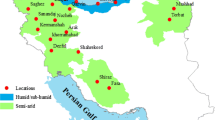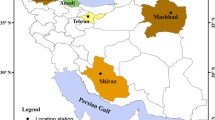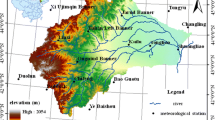Abstract
The temporal trend of reference crop evapotranspiration (ET0) and contribution of associated meteorological factors to the ET0 trend were assessed for 17 arid areas. Sensitivity of ET0 to changes in key meteorological variables was also analyzed. To study temporal trend of ET0, Mann-Kendall trend test was employed. Quantitative contribution and sensitivity analyses were carried out, respectively, using a dimensionless relative sensitivity coefficient and detrending method. Results indicated that ET0 has an increasing trend in 70.6, 64.7, 70.6, 76.5 and 70.0%, of sites respectively, in winter, spring, summer, autumn and entire year. This positive trend was significant (p ≤ 0.05) in 47.0, 35.3, 35.3, 29.4 and 35.3% of sites, respectively, for the same seasons. There was a significant change-point in winter, spring, summer, autumn and annual ET0 series at 64.7, 52.9, 64.7, 64.7 and 82.3% of stations, respectively. In 35.3 and 35.3% of sites, solar radiation and wind speed were the most sensitive climatic factors on ET0, respectively. ET0 exhibited the highest sensitivity to the relative humidity changes in coastal sites. Changes of wind speed contributed much more than other factors to the annual ET0 trend in 58.8% of investigated sites. The negative trend in wind speed nearly nullified the positive effects of increased air temperature on ET0 over 1966–2012 in 23.5% of stations. Changes in ET0 were attributed to wind speed changes in most locations. Given the upward trend of ET0 in the majority of locations, proper water management is required to avoid negative impacts of climate change in arid regions.







Similar content being viewed by others
References
Al-Faraj FAM, Tigkas D, Scholz M (2016) Irrigation efficiency improvement for sustainable agriculture in changing climate: a transboundary watershed between Iraq and Iran. Environmental Process 3:603–616
Alizadeh A, Keshavarz A (2005) Status of agricultural water use in Iran. In: Water conservation, reuse, and recycling: proceedings of an Iranian-American workshop. National Academies Press, Washington DC, pp 94–105
Allen RG, Pereira LS, Raes D, Smith M (1998) Crop evapotranspiration-guidelines for computing crop water requirements-FAO irrigation and drainage paper 56. FAO, Rome 300:6541
Busuioc A, von Storch H (1996) Changes in the winter precipitation in Romania and its relation to the large-scale circulation. Tellus A 48:538–552
Chen D, Gao G, Xu C-Y, Guo J, Ren G (2005) Comparison of the Thornthwaite method and pan data with the standard Penman-Monteith estimates of reference evapotranspiration in China. Clim Res 28:123–132
Debnath S, Adamala S, Raghuwanshi NS (2015) Sensitivity analysis of FAO-56 Penman-Monteith method for different agro-ecological regions of India. Environ Process 2:689–704. doi:10.1007/s40710-015-0107-1
Dinpashoh Y, Jhajharia D, Fakheri-Fard A, Singh VP, Kahya E (2011) Trends in reference crop evapotranspiration over Iran. J Hydrol 399:422–433
Estévez J, Gavilán P, Berengena J (2009) Sensitivity analysis of a Penman–Monteith type equation to estimate reference evapotranspiration in southern Spain. Hydrol Process 23:3342–3353. doi:10.1002/hyp.7439
Gao Z, He J, Dong K, Bian X, Li X (2016) Sensitivity study of reference crop evapotranspiration during growing season in the West Liao River basin, China. Theor Appl Climatol 124:865–881
Godfray HCJ, Beddington JR, Crute IR, Haddad L, Lawrence D, Muir JF, Pretty J, Robinson S, Thomas SM, Toulmin C (2010) Food security: the challenge of feeding 9 billion people. Science 327:812–818
Gong L, Xu C-y, Chen D, Halldin S, Chen YD (2006) Sensitivity of the Penman–Monteith reference evapotranspiration to key climatic variables in the Changjiang (Yangtze River) basin. J Hydrol 329:620–629
Homaee M, Dirksen C, Feddes R (2002) Simulation of root water uptake: I. Non-uniform transient salinity using different macroscopic reduction functions. Agric Water Manag 57:89–109
Homaee M, Schmidhalter U (2008) Water integration by plants root under non-uniform soil salinity. Irrig Sci 27:83–95
Huo Z, Dai X, Feng S, Kang S, Huang G (2013) Effect of climate change on reference evapotranspiration and aridity index in arid region of China. J Hydrol 492:24–34
Hupet F, Vanclooster M (2001) Effect of the sampling frequency of meteorological variables on the estimation of the reference evapotranspiration. J Hydrol 243:192–204
IPCC (2013) Climate change 2013: the physical science basis. Contribution of Working Group I to the Fifth Assessment Report of the Intergovernmental Panel on Climate Change, Cambridge and New York
Irmak S, Payero JO, Martin DL, Irmak A, Howell TA (2006) Sensitivity analyses and sensitivity coefficients of standardized daily ASCE-Penman-Monteith equation. J Irrig Drain Eng 132:564–578
Kaniewski D, Van Campo E, Weiss H (2012) Drought is a recurring challenge in the Middle East. Proc Natl Acad Sci 109:3862–3867
Kite G, Droogers P (2000) Comparing evapotranspiration estimates from satellites, hydrological models and field data. J Hydrol 229:3–18
Liu Q, Yang Z, Cui B, Sun T (2010) The temporal trends of reference evapotranspiration and its sensitivity to key meteorological variables in the Yellow River basin, China. Hydrol Process 24:2171–2181
Maestro T, Nicolosi V, Cancelliere A, Bielza M (2014) Impacts of climate change, hydrological drought mitigation measures and irrigation demand on water supply system performance. Eur Water 45(46):25–33
McCuen RH (1974) A sensitivity and error analysis cf procedures used for estimating evaporation. JAWRA J Am Water Resour Assoc 10:486–497. doi:10.1111/j.1752-1688.1974.tb00590.x
Modarres R, Sarhadi A (2009) Rainfall trends analysis of Iran in the last half of the twentieth century. J Geophys Res Atmos 114:D03101. doi:10.1029/2008JD010707
Monteith J, Unsworth M (2013) Principles of environmental physics: plants, animals, and the atmosphere (Fourth Edition). Academic Press, Boston
Mosaedi A, Sough MG, Sadeghi S-H, Mooshakhian Y, Bannayan M (2016) Sensitivity analysis of monthly reference crop evapotranspiration trends in Iran: a qualitative approach. Theor Appl Climatol:1-17. doi:10.1007/s00704-016-1740-y
Nouri M, Homaee M, Bannayan M, Hoogenboom G (2016) Towards modeling soil texture-specific sensitivity of wheat yield and water balance to climatic changes. Agric Water Manag 177:248–263. doi:10.1016/j.agwat.2016.07.025
Pettitt A (1979) A non-parametric approach to the change-point problem. Appl Stat 28:126–135
Roderick ML, Rotstayn LD, Farquhar GD, Hobbins MT (2007) On the attribution of changing pan evaporation. Geophys Res Lett 34:L17403. doi:10.1029/2007GL031166
Saxton KE (1975) Sensitivity analyses of the combination evapotranspiration equation. Agric Meteorol 15:343–353
Seneviratne SI, Corti T, Davin EL, Hirschi M, Jaeger EB, Lehner I, Orlowsky B, Teuling AJ (2010) Investigating soil moisture–climate interactions in a changing climate: a review. Earth-Sci Rev 99:125–161
Shan N, Shi Z, Yang X, Zhang X, Guo H, Zhang B, Zhang Z (2015) Trends in potential evapotranspiration from 1960 to 2013 for a desertification-prone region of China. Int J Climatol 36:3434–3445
Sharifi A, Dinpashoh Y (2014) Sensitivity analysis of the Penman-Monteith reference crop evapotranspiration to climatic variables in Iran. Water Resour Manag 28:5465–5476. doi:10.1007/s11269-014-0813-x
Shenbin C, Yunfeng L, Thomas A (2006) Climatic change on the Tibetan Plateau: potential evapotranspiration trends from 1961–2000. Clim Chang 76:291–319. doi:10.1007/s10584-006-9080-z
Some'e BS, Ezani A, Tabari H (2012) Spatiotemporal trends and change point of precipitation in Iran. Atmos Res 113:1–12
Song Y, Su XL (2015) Sensitivity of reference crop evapotranspiration in Shaanxi Province. In: Zhou P, Patty A (eds) Applied mechanics and materials, vol 700. Trans Tech Publ, Zurich, pp 374–385
Tabari H, Talaee PH (2011) Analysis of trends in temperature data in arid and semi-arid regions of Iran. Glob Planet Chang 79:1–10
UNEP (1992) World atlas of desertification. United Nations Environment Programme, London
Xie H, Zhu X (2013) Reference evapotranspiration trends and their sensitivity to climatic change on the Tibetan Plateau (1970–2009). Hydrol Process 27:3685–3693
Xie H, Zhu X, Yuan DY (2015) Pan evaporation modelling and changing attribution analysis on the Tibetan Plateau (1970–2012). Hydrol Process 29:2164–2177
Xu C-y, Gong L, Jiang T, Chen D, Singh VP (2006) Analysis of spatial distribution and temporal trend of reference evapotranspiration and pan evaporation in Changjiang (Yangtze River) catchment. J Hydrol 327:81–93. doi:10.1016/j.jhydrol.2005.11.029
You G, Zhang Y, Liu Y, Song Q, Lu Z, Tan Z, Wu C, Xie Y (2013) On the attribution of changing pan evaporation in a nature reserve in SW China. Hydrol Process 27:2676–2682. doi:10.1002/hyp.9394
Yue S, Pilon P, Phinney B, Cavadias G (2002) The influence of autocorrelation on the ability to detect trend in hydrological series. Hydrol Process 16:1807–1829
Zhang Y, Liu C, Tang Y, Yang Y (2007) Trends in pan evaporation and reference and actual evapotranspiration across the Tibetan Plateau. J Geophys Res Atmos 112:D12110. doi:10.1029/2006JD008161
Author information
Authors and Affiliations
Corresponding author
Rights and permissions
About this article
Cite this article
Nouri, M., Homaee, M. & Bannayan, M. Quantitative Trend, Sensitivity and Contribution Analyses of Reference Evapotranspiration in some Arid Environments under Climate Change. Water Resour Manage 31, 2207–2224 (2017). https://doi.org/10.1007/s11269-017-1638-1
Received:
Accepted:
Published:
Issue Date:
DOI: https://doi.org/10.1007/s11269-017-1638-1




